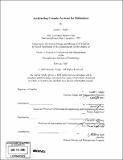Architecting complex systems for robustness
Author(s)
Slagle, Jason C
DownloadFull printable version (41.44Mb)
Other Contributors
System Design and Management Program.
Advisor
Daniel D. Frey and Edward F. Crawley.
Terms of use
Metadata
Show full item recordAbstract
Robust design methodologies are frequently utilized by organizations to develop robust and reliable complex systems. The intent of robust design is to create systems that are insensitive to variations from production, the environment, and time and use. While this process is effective, it can also be very time consuming and resource intensive for an engineering team. In addition, most robust design activity takes place at the detailed design phase, when the majority of the product life cycle cost has already been committed. Addressing robustness and the "ilities" at the architecture level may be more effective because it is the earliest and highest leverage point in the product development process. Furthermore, some system architectures are inherently more robust than others. In this thesis, a framework based on principles is proposed to architect complex systems for type I and II robustness. The principles are obtained by tracing the architectural evolution of the jet engine, which is an extremely complex system that has evolved to high reliability. This framework complements existing robust design methods, while simultaneously incorporating the robustness focus earlier in the product development process.
Description
Thesis (S.M.)--Massachusetts Institute of Technology, System Design and Management Program, 2007. Vita. Includes bibliographical references (p. 121-128).
Date issued
2007Department
System Design and Management Program.Publisher
Massachusetts Institute of Technology
Keywords
System Design and Management Program.